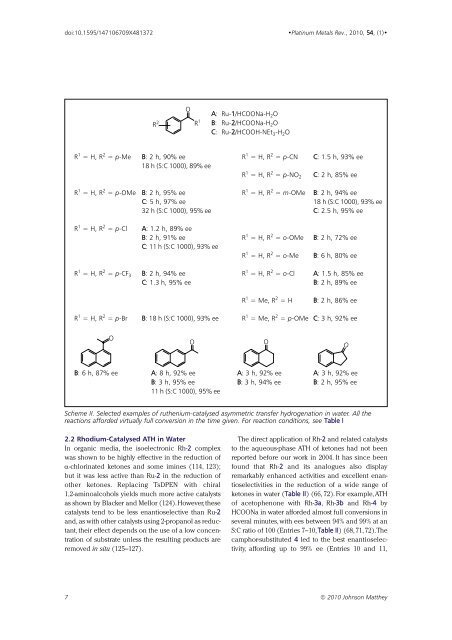Download Issue PDF - Platinum Metals Review
Download Issue PDF - Platinum Metals Review
Download Issue PDF - Platinum Metals Review
Create successful ePaper yourself
Turn your PDF publications into a flip-book with our unique Google optimized e-Paper software.
doi:10.1595/147106709X481372<br />
•<strong>Platinum</strong> <strong>Metals</strong> Rev., 2010, 54, (1)•<br />
R 2<br />
O<br />
R 1<br />
A: Ru-1/HCOONa-H 2 O<br />
B: Ru-2/HCOONa-H 2 O<br />
C: Ru-2/HCOOH-NEt 3 -H 2 O<br />
R 1 = H, R 2 = p-Me B: 2 h, 90% ee R 1 = H, R 2 = p-CN C: 1.5 h, 93% ee<br />
18 h (S:C 1000), 89% ee<br />
R 1 = H, R 2 = p-NO 2 C: 2 h, 85% ee<br />
R 1 = H, R 2 = p-OMe B: 2 h, 95% ee R 1 = H, R 2 = m-OMe B: 2 h, 94% ee<br />
C: 5 h, 97% ee 18 h (S:C 1000), 93% ee<br />
32 h (S:C 1000), 95% ee C: 2.5 h, 95% ee<br />
R 1 = H, R 2 = p-Cl<br />
A: 1.2 h, 89% ee<br />
B: 2 h, 91% ee R 1 = H, R 2 = o-OMe B: 2 h, 72% ee<br />
C: 11 h (S:C 1000), 93% ee<br />
R 1 = H, R 2 = o-Me B: 6 h, 80% ee<br />
R 1 = H, R 2 = p-CF 3 B: 2 h, 94% ee R 1 = H, R 2 = o-Cl A: 1.5 h, 85% ee<br />
C: 1.3 h, 95% ee B: 2 h, 89% ee<br />
R 1 = Me, R 2 = H<br />
B: 2 h, 86% ee<br />
R 1 = H, R 2 = p-Br B: 18 h (S:C 1000), 93% ee R 1 = Me, R 2 = p-OMe C: 3 h, 92% ee<br />
O<br />
O<br />
O<br />
O<br />
B: 6 h, 87% ee A: 8 h, 92% ee A: 3 h, 92% ee A: 3 h, 92% ee<br />
B: 3 h, 95% ee B: 3 h, 94% ee B: 2 h, 95% ee<br />
11 h (S:C 1000), 95% ee<br />
Scheme II. Selected examples of ruthenium-catalysed asymmetric transfer hydrogenation in water. All the<br />
reactions afforded virtually full conversion in the time given. For reaction conditions, see Table I<br />
2.2 Rhodium-Catalysed ATH in Water<br />
In organic media, the isoelectronic Rh-2 complex<br />
was shown to be highly effective in the reduction of<br />
α-chlorinated ketones and some imines (114, 123);<br />
but it was less active than Ru-2 in the reduction of<br />
other ketones. Replacing TsDPEN with chiral<br />
1,2-aminoalcohols yields much more active catalysts<br />
as shown by Blacker and Mellor (124).However,these<br />
catalysts tend to be less enantioselective than Ru-2<br />
and, as with other catalysts using 2-propanol as reductant,<br />
their effect depends on the use of a low concentration<br />
of substrate unless the resulting products are<br />
removed in situ (125–127).<br />
The direct application of Rh-2 and related catalysts<br />
to the aqueous-phase ATH of ketones had not been<br />
reported before our work in 2004. It has since been<br />
found that Rh-2 and its analogues also display<br />
remarkably enhanced activities and excellent enantioselectivities<br />
in the reduction of a wide range of<br />
ketones in water (Table II) (66, 72). For example,ATH<br />
of acetophenone with Rh-3a, Rh-3b and Rh-4 by<br />
HCOONa in water afforded almost full conversions in<br />
several minutes, with ees between 94% and 99% at an<br />
S:C ratio of 100 (Entries 7–10, Table II) (68,71,72).The<br />
camphor-substituted 4 led to the best enantioselectivity,<br />
affording up to 99% ee (Entries 10 and 11,<br />
7 © 2010 Johnson Matthey
















